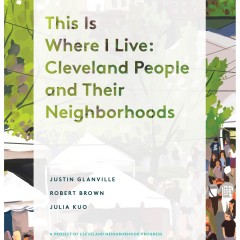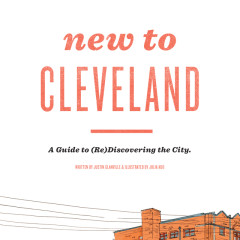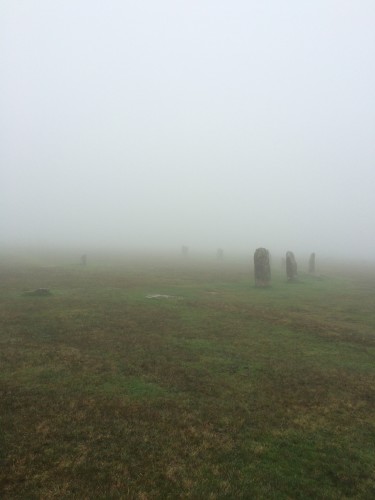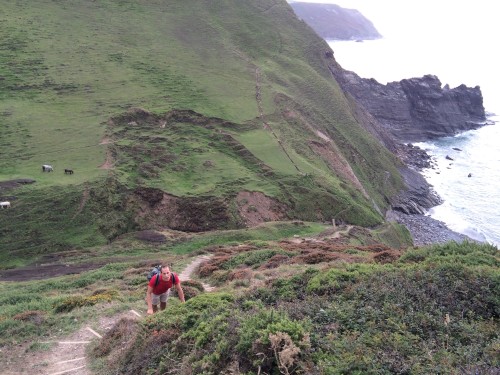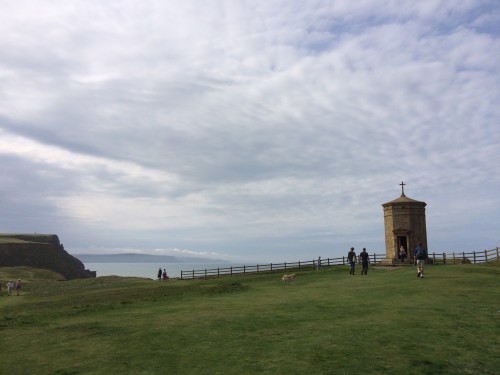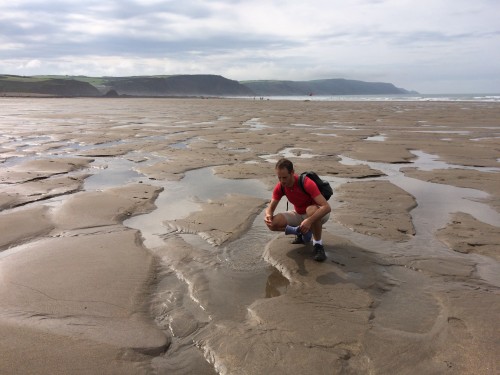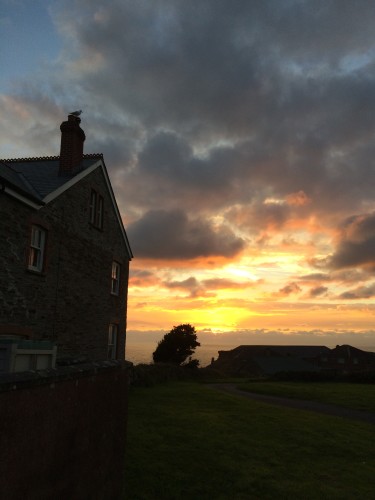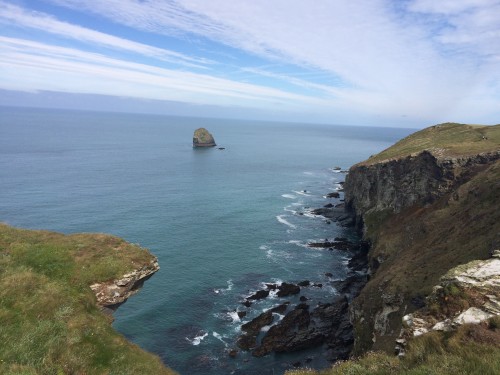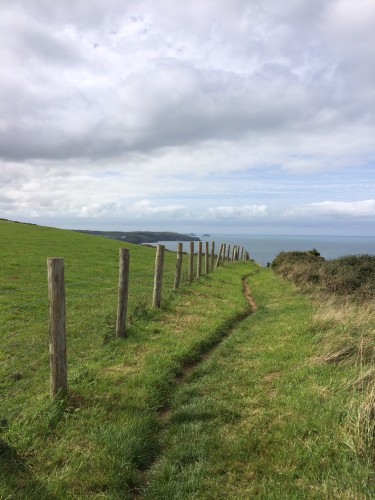Cornwall’s spectacular coast path remains unknown to many Americans
On about the 100th granite step above Port William, on Cornwall’s north coast, my boyfriend managed a few strangled words.
“These people,” he panted, “are crazy.”
I’m not sure whether he was referring to the builders of the trail we were hiking — the South West Coast Path — or to the Cornish in general, for living in such rugged terrain. Either might apply.
But bemused resentment wasn’t the only emotion we were feeling. There was also, as always, admiration — for the staggering beauty everywhere around us. Rolling, brilliant green pastureland atop pitch-black volcanic rock cliffs; empty blond beaches punctuating rocky coves; the crashing blue sea.
And seals! Gray, squiggling seals!
We were on the final day of a four-day walk on the trail, which careers its way along 630 miles of the famously jagged coast of Devon and Cornwall, at the southwestern tip of England. It was the second part of my two-week pilgrimage to Cornwall to reconnect with my family roots.
The challenges and beauty of the trail thrilled me, but I was almost as surprised by how few non-English folk we encountered along the way.
This is a trail that should be on the radar of long-distance hikers everywhere, as much for its natural wonders as its cultural ones. Where else in the world can you end a blood-pumping day’s hike with a wander through King Arthur’s (purported) hometown or a visit to a creepy museum of witchcraft — all without ever having to set foot in a car or even diverge from the trail?
By day, the South West Coast Path awes you — with staggering, remote, windswept beauty. (And seals!)
By night, it comforts you — with tidy small towns, warm pubs, and delicious “cream teas” of homemade scones, clotted cream and jam.
This is still England, after all. Coziness is just part of the deal.
Understanding Cornwall
Cornwall is the “toe” of England, a craggy land of sheer cliffs and beaches that was remote enough to have retained a separate Celtic identity and even its own language (Cornish) for hundreds of years following the Saxon and Norman invasions of Britain.
Today, some of that sense of “a place apart” from the rest of England survives, though it’s not as pronounced as in Scotland, Wales or Ireland. There’s a movement to revive the Cornish language in schools, and as of the 2011 English Census, people can identify themselves as being of Cornish ethnicity. Some street signs and public notices are now bilingual.
Cornwall has long held a place in the popular imagination as a place of magic, romance — and Gothic spookiness. Its landscapes are as if made for story: Dramatic sea cliffs for heroes on horseback to thunder across; foggy moorland for villains to prowl; ancient stone circles for pagans to worship.
The half-historical, half-mythical King Arthur is said to have been born here, and novelist Daphne du Maurier used Cornwall as the backdrop for her most famous tales, including Rebecca, Jamaica Inn and “The Birds.” Winston Graham’s Poldark series of novels, now enjoying a revival through an enjoyably trashy PBS series, also unravel in Cornwall.
Being so closely embraced by the sea, Cornwall enjoys temperate weather all year round. It’s not exactly “warm” by the standards of anyone but the English, with summer temperatures rarely exceeding 70. On the other hand, winter lows seldom sink beneath 40. (Fortunately, that’s about my ideal temperature range!)
What makes the place so physically beautiful, I think, is its unique combination of wildness and domesticity. The fierce Atlantic Ocean is never much more than 10 miles away, and Cornwall meets it foreboding volcanic cliffs, soft agrarian landscapes and cozy small towns — a combination that manages to excite and soothe all at once.
A Note About Cornish Tourism
Today, Cornwall has both the blessing and the curse of being a top spot for domestic tourism, drawing visitors from throughout England (and a few from abroad) with its temperate maritime weather and stunning scenery. Tourism provides much-needed revenue for a county that has England’s highest poverty rates. But many towns — especially those on the coasts — have been almost entirely commodified as playlands for holiday makers and second-home-owners. Trinket shops and foodie restaurants have replaced post offices, schools and corner groceries. The coastal towns are still beautiful; they just don’t feel especially “real.”
To get a taste of real-world Cornwall, you’ll have to go inland — to the farm towns and small cities that lie out of viewing distance of the sea. You can hardly go wrong, but St. Neot, Altarnun and the administrative capital of Truro are all gorgeous. A visit to some of these places can balance the more tourist-centric experience of the coast towns.
Preparing to Hike
The first thing to decide is how much of a Bad-Ass you want to be about your hike. The South West Coast Path (SWCP) can accommodate everyone from leisurely day-hikers to fierce, fancy-shades-and-backpack trail warriors.
Even at a moderate pace, the SWCP is no leisurely amble. The Cornish coast is made up of a series of stream valleys that have cut through high cliffs to the sea. That means you’re usually heading either up- or downhill — sometimes at near-vertical grades, though the steepest hills have stairs to help you along.
To do anything more than a day hike, you’ll benefit from strong thighs, a sturdy lower back and steady shoulders for carrying sufficient water and snacks. If you’re going for a multi-day hike, you’ll need to think about accommodation and how you’re going to transport your stuff each day. Do you want to camp or stay in B&B’s and hotels? This will determine where you stay each night and how far you’ll walk.
As for your stuff, your two options are to schlep it yourself, or pay a luggage transfer company to move it for you each day. The going rate for the latter starts at about £7.50 ($9.75) per bag. We decided that was worth the reduced toil on the trail, especially since we were spending a week in Cornwall before our hike and had to pack accordingly.
Here’s a range of different ways you could approach your journey:
1. Just a simple day hike, thanks. If you’re pressed for time or aren’t an experienced hiker, you can get a taste of the Coast’s power and beauty in a walk of just a few miles, with no need to plan logistics. The stretch from Boscastle to Tintagel (see below) is a good candidate.
2. A few days of coastal glory, complete with cream teas and pubs. A hike of between three to five days will let you immerse yourself in Cornwall’s beauty, experience solitude and sample a range of towns, beaches and landscapes. You need to be reasonably fit but by no means an expert hiker, and you can stay in cozy, affordable B&B’s, with your luggage professionally transferred each day. Don’t forget to try a Cornish “cream tea” — a piping-hot pot of black tea and scones topped with jam and clotted cream (a cross between butter and whipped cream).
3. I want to win the Coast Path! If you’re an experienced backpacker, you could tackle the entire SWCP head-on, carrying all your own stuff, camping, and aiming for something like 15 or more miles a day. The journey all the way around Cornwall could take as little as two and a half weeks.
(While on the trail, we also met a woman who was taking the unorthodox approach of basing herself in a single town and taking day hikes in both directions from there. She had to return to the same town each night and repeat some of the same scenery, but in exchange got to avoid logistical hassles.)
We opted for #2, and I’ll describe my experience in more detail below. To get more detailed about your own journey, check out the invaluable Cornwall Coast Path guide, which contains dozens of maps, itineraries, information about elevation changes, and B&B and campsite listings.
Lastly, if you don’t feel like doing any of your own planning, you can hire the very friendly and professional Encounter Walking Holidays to do it for you. They’ll advise you on an itinerary and quote you a package that includes accommodation, transport, and luggage transfers if needed — though of course you’ll pay a premium over booking everything yourself.
Getting to the Path
Depending on where you’re going, Cornwall can be reached in between four and six hours from London by train, bus or car. There’s only one main train line, the Great Western Railway, which runs across the interior of the county all the way to Penzance.
Reaching the Coast Path by public transport can be a bit complicated and will probably involve buses (here’s a handy bus route planner), unless you’re going to Looe, Newquay or Falmouth, all of which are served by rail spurs from the main line. Renting a car would seem to solve the problem — except you have to park it somewhere and get back to it at the end of your hike.
For us, the solution was to splurge on taxis, arranged through Luggage Transfers Ltd., so that we could start and end where we wanted. (Uber hasn’t really penetrated Cornwall yet.)
Distance and Time
Our average distance on the trail each day was about 7 miles. Our longest day was 10 miles (Bude to Lower Tresmorn), and our shortest was 5 (Boscastle to Tintagel). However, according to my trusty iPhone, we ended up walking at least 11-15 miles every day overall because of all the extra time exploring towns or side paths.
Our average trail pace, given time to ogle the views, rest from punishing ascents and eat lunch, was about 2 miles an hour. That means our longest day was about 5 hours of hiking.
Accommodation
We stayed in B&B’s as opposed to camping. Remember about wanting the cream tea and coziness? TripAdvisor is a good resource, but much more comprehensive is the website of — once again — Luggage Transfers Ltd., which has listings for all towns along the Cornish coast. Note that many of these places are tiny, mom-and-pop operations, and to make reservations you’ll have to email or call them with your credit card details. A few places have minimum two-night stays.
Clothing and Boots
Layers are the answer to Cornwall’s famously changeable weather. I’d recommend at least three: a T-shirt, a base thermal layer and an outer layer (perhaps fleece). One day was warm enough that I wore a T-shirt the whole time, while one chilly morning I bundled up in all three layers. We were lucky enough never to have significant rain, but a light raincoat is also essential. On my lower half, I wore shorts because I like the freedom of movement they afford, and high-ankle waterproof hiking boots.
Stuff
As mentioned above, we had our main luggage transferred every day. But each of us toted day-packs to contain our unused clothing layers; a two-liter water bladder; food; maps and a guidebook. Sunscreen and a hat are also advisable, because there’s no shade.
Food and Water
The only places to get sustenance on the trail are in the towns, so you’ll have to plan ahead for lunch and snacks. Most towns have a small supermarket or deli, so in the mornings before setting off you can buy sandwiches, granola bars and nuts to get you through the day.
Our Trip
Route
We ended up doing a four-day, four-night hike beginning in Bude and ending in Port Isaac. I picked this section because it has Cornwall’s tallest cliffs, some beautiful beaches and a series of appealing small towns to explore. On no count were we disappointed!
Here was our itinerary:
Day 1. Bude to Lower Tresmorn/Crackington Haven (10 miles).
Bude is a sprawling resort town without a ton of personality, but it makes for a good starting point because it’s large enough to offer stores and amenities where you can buy anything you’ve forgotten at home. As you hike southwest from here, the views are immediately stunning. A highlight is Widemouth (pronounced Wid-muth) Beach, where you’ll see surfers and dramatic, web-like tidal patterns in the sand.
B&B: Lower Tresmorn Farm. An ancient and beautifully restored farmhouse in the hamlet of Lower Tresmorn, a couple miles north of Crackington Haven. Note: There’s nowhere to eat in Lower Tresmorn, so if you stay here, you’ll have to either bring your own dinner (as we did), or hike two miles into Crackington for a pub meal.
Day 2. Lower Tresmorn to Boscastle (9 miles).
This was my favorite day — and not just because of the seals at Beeny Cliff (see below). The landscapes are uniformly stunning, with the highest cliffs in Cornwall framing idyllic beaches and blue-green sea. More often than not, your only company will be sheep and goats. Boscastle also boasts an enthusiastically-curated Museum of Witchcraft and Magic.
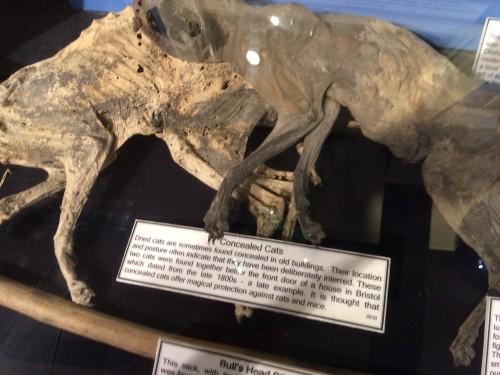
Museum of Witchcraft: Dead cats were once stored inside walls to provide magical protection against rats and mice
B&B: The Bridge House. A perfectly serviceable if generic place above a cafe, in the center of town. The “power shower” was epic and alone worth the price — hot and massage-like after a long day’s hike.
Day 3. Boscastle to Tintagel (5 miles).
Our shortest and easiest day, and a good candidate for a day hike: The views remain spectacular, but the path is more level. You won’t experience much solitude here, though, given the proximity to King Arthur’s castle and a huge RV park near Tintagel. We added to our hike by taking a 2-mile side walk into Rocky Valley, which has become a New Age mecca due to some 200-year-old labyrinth carvings on boulders. Tintagel itself was a pleasant surprise, touristy but with a woo-woo streak (think Tarot cards and healers) that gave it an identity beyond being cute (see Port Isaac).
B&B: Trevenna Lodge. Far and away the best place we stayed, a newer house with spacious rooms a short walk from Tintagel’s center. The hostess was warm and friendly without being intrusive, even doing our laundry for us, and keeps a huge stock of DVD’s for guests to watch in their rooms. The kind of place I’d have liked to linger for a few days.
Day 4. Tintagel to Port Isaac (9 miles).
Some very tough hiking on this stretch, with the ascent out of Port William (“These people are crazy”) the standout amidst a series of testing hills. The scenery was a notch lower in grandiosity compared with the previous two days, though still gorgeous. Port Isaac, meanwhile, was my least favorite of the towns we stayed. It’s pretty but mobbed with tourists making Doc Martin pilgrimages (a show virtually unknown to Americans but very popular in the UK) — and the attendant merchants vying for their money.
B&B: The Old School Hotel. Our least favorite place, overpriced and a bit dreary, especially coming on the heels of Trevenna. Small room, not especially clean, in a characterless annex to a pretty old school building. Servers in the attached restaurant were unfriendly.
The next morning, we took a 40-minute taxi ride from Port Isaac to the nearest train station, at Bodmin Parkway. From here, it was an easy 4-hour train ride back to London, where we spent our last two nights.
Other Questions
Can I go swimming in the ocean?
You can! The ocean temperature hovers around 65 all year round — manageable if bracing. That said, the only people we saw in any depth of water were surfers, many of them in wet suits. That was part of the reason we didn’t end up swimming ourselves, though we’d planned to. The other reason was that we never quite worked up enough heat or sweat to make a cold swim appealing. As always, if you do want to go swimming, check online first whether that beach’s currents are safe.
Where do I see the seals!!
The hot spot for us was along Beeny Cliff, a remote spot a couple miles northeast of Boscastle. I expected to see them basking on rocks like in the nature documentaries, but instead they were in the water, swimming and squiggling around, sometimes in pairs. Enchanting! You can also see dolphins along this stretch sometimes, though alas we did not.
Why do you keep talking about the cream tea.
Because it is delicious. Just ask The Cream Tea Society.
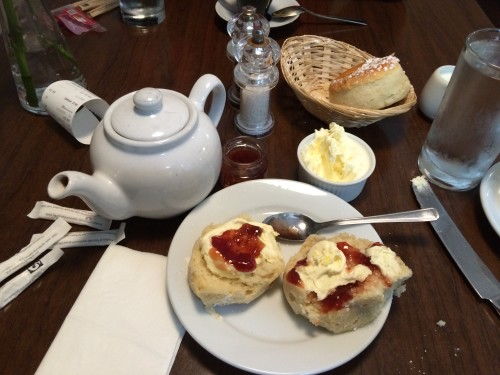
Cream tea! Scone on left has cream below jam (Devon style); on the right has jam below cream (Cornwall style)
How about other food?
Foodie-ism is increasingly reaching Cornwall, with each coastal town now home to at least one Fancy Restaurant boasting local ingredients. However, heavy “pub grub” is still the rule. Several nights, to avoid yet another meal of greasy potatoes and limp vegetables, we bought salad stuff from the grocery stores, borrowed plates and silverware from the B&B, and ate dinner in our rooms.
Can I wing accommodation, so I can play my daily hiking distance by ear?
Not advisable. Cornwall’s a popular spot, and B&B’s fill up months in advance. You’ll be tired at the end of each day’s walk, and it’d be a real bummer to wander around towns looking for a place to stay. However, improvisation could be an option if you’re camping.
At the B&B’s, do I have to sit around in the morning talking to a bunch of strangers over crumpets?
No. British B&B’s are different from ours — more functional, less fusty, fewer rickety antiques. In every place we stayed, breakfast was served at private tables and we could socialize as much or as little as we pleased.
What would you do differently if you were to repeat the trip?
I’d probably skip overpriced and overcrowded Port Isaac, spending two nights in Tintagel to rest up for an extra-long press from there to Polzeath (about 15 miles). Other than that, very little. The 4-day itinerary was perfect for us, long enough to feel immersed but short enough to avoid trail fatigue.
Feel free to let me know how your own trek goes!



